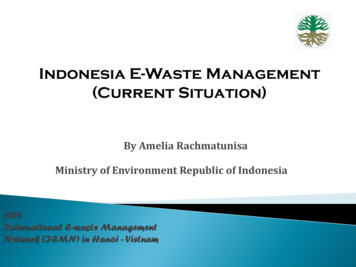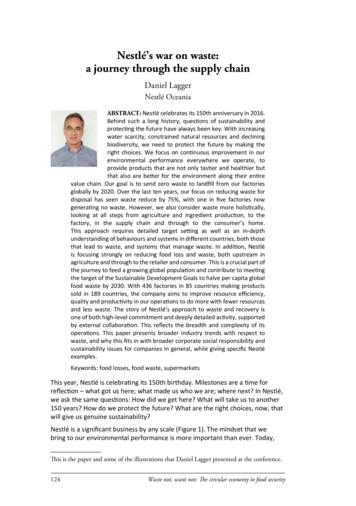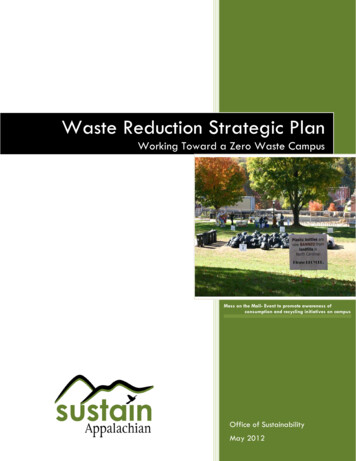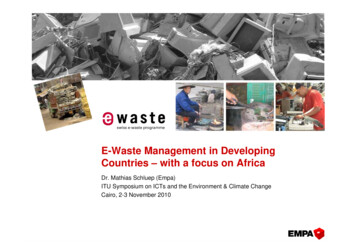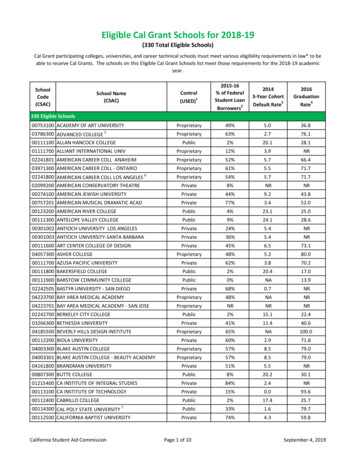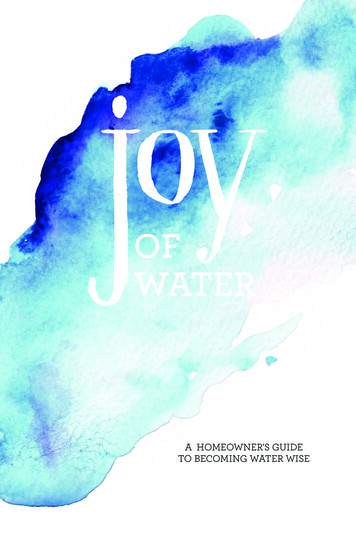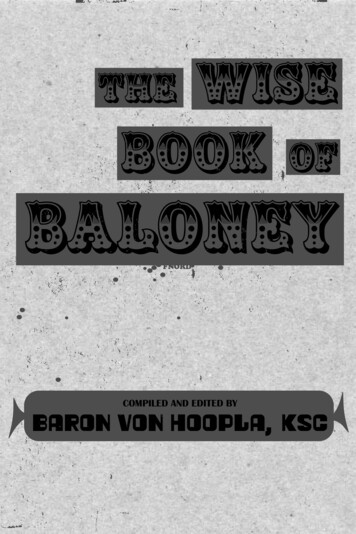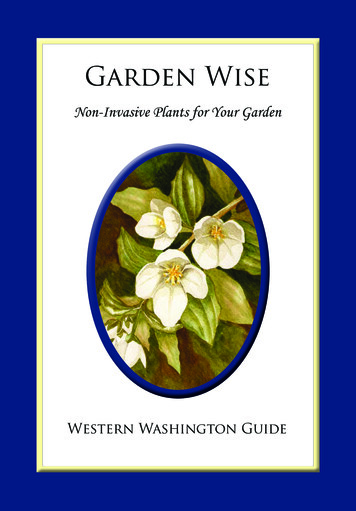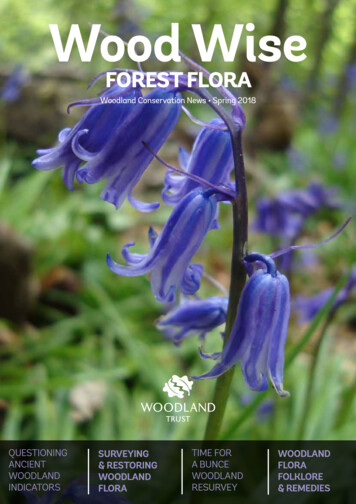
Transcription
The Waste Wise Schools ProgramHealthy Zero WasteLunch Toolkit
AcknowledgmentsWritten by Danielle RalphIllustrations by Rod WallerDesigned by Su-Anne Lee, Design BrewEdited byCara WilliamsJennifer WestonPatrick HamillWendy AspdenThis guide was developed by the Waste Wise Schools Program which is managed bythe Department of Water and Environmental Regulation and supported by the WesternAustralian Waste Authority through the Waste Management and Recycling Account.The Waste Wise Schools Program would like to thank Clayton Chipper, HealthPromotion Officer, Department of Health for providing school healthy eating informationas well as the Keep Australia Beautiful Council WA for granting the use of their littereducation resources.For more information about the program please contact:The Waste Wise Schools ProgramDepartment of Water and Environmental RegulationLocked Bag 104Bentley Delivery Centre, WA 6983Phone: (08) 6364 7000Email: wastewise@dwer.wa.gov.auWeb: www.wastewise.wa.gov.au2
ContentsIntroductionChapter 1Waste Wise Schools ProgramAbout the Waste Wise Schools ProgramThe Waste Wise Schools philosophy and its connection to (AuSSI)Chapter 2Healthy zero waste lunchWhat is a healthy zero waste lunch?Why should we have a healthy zero waste lunch?The problem with litterContributing to a healthy dietChapter 3How to conduct a healthy zero waste lunch dayPlan itSet it upRun itKeep it goingChapter 4Healthy zero waste lunch day toolsHealthy zero waste lunch scope and sequence plannerScope and sequence tableLesson plans and resourcesData collection lesson planWaste Wise Schools Program – Healthy zero waste lunch class recordsInside the lunch box lesson planSultana experiment lesson planPotato packaging lesson plan – One potato, two potato, three potato, more!Food diary lesson planMessage in a bottle lesson planMessage in a bottle information sheetThe main stages of a materials life-line (pictorial)Disposable culture lesson planKAB litter audit instructions – quadrant countKAB litter audit record sheetExample letter to advertise a healthy zero waste lunch dayStudent certificateStudent 232527283031323335363
IntroductionThe Healthy Zero Waste Lunch Toolkit is an operating practices manual that is intended to guidethe development and implementation of healthy zero waste lunches in schools. These are anexcellent way to educate the school community about how to reduce their waste production anddevelop sustainable behaviours that support this philosophy.This toolkit has been designed to promote best practice however, there is no right or wrong way toconduct healthy zero waste lunches within a school setting. The key is finding what works for yourschool and every attempt has been made to offer ideas and suggestions that can be tailored for theneeds of individual schools, classrooms and students.Good luck and we hope you enjoy your journey to becoming more waste wise!The Waste Wise TeamFor more information, go to:www.wastewise.wa.gov.au4
Chapter 1Waste Wise Schools ProgramAbout the Waste Wise Schools ProgramWaste Wise Schools throughout Western Australia (WA) are reducing waste by implementing the 3Rs – reduce,reuse, recycle – while developing positive environmental values in students and the whole school community.Waste Wise schools model responsible environmental behaviours through hands-on learning experiences thatare linked to the Australian Curriculum. The program helps schools set up infrastructure and providesresources aimed at changing attitudes and behaviours in regards to sustainable waste management. Theprogram is free and available to all schools in WA.The Waste Wise Schools philosophy and its connection to Australian SustainableSchools Initiative (AuSSI)The Waste Wise Schools Program has been developed based on best practice Education for Sustainability(EfS) principles. The overarching message of the program is to reduce, reuse and recycle to promote thesustainable use of natural resources and minimise our collective environmental footprint.Through participation in the Waste Wise Schools Program, your school has already begun participating inAuSSI-WA, and can formally register and learn more about it through the online toolkit. For further informationregarding the Sustainable Schools Initiative WA, visit the project ableschools.5
Chapter 2Healthy zero waste lunchWhat is a healthy zero waste lunch?A healthy zero waste lunch does not contain throwaway packaging or produce food waste. It also reduces litterbecause there is less packaging. The typical healthy zero waste lunch is packed in alunch box or bag. The food is put in reusable containers rather than wrapped indisposable packaging, a drink is in a refillable bottle and all containers areresealable so that leftover food and drink can be saved for later.Why should we have a healthy zero waste lunch?By bringing less waste into schools we can minimise litter, reduce wastegoing to landfill, save money and develop healthy eating habits. Producingexcessive amounts of waste is a major problem in Australia, with Australia beingthe second highest producer of waste per person when compared to other westerncountries.Australians produce 41 million tonnes of waste each year. This amountof waste would fill a line of garbage trucks from Perth to London.Recent statistics also reveal that WA produces significantly more wastethan the rest of Australia and diverts the smallest amount of wastefrom landfill (Hyder Consulting, 2008). These statistics highlight theneed for an immediate reduction in our waste production.The problems with litterA significant proportion of the waste we produce also endsup as litter. This can be in the form of windblown wastefrom landfill sites or rubbish bins and from individuals incorrectly disposing their rubbish. The results from the National Litter Countfor 2009–10 found that WA was the second most littered state in Australia. Figures fromthis research also indicated that although cigarette butts were the most frequently identified item across allsites, plastic items contributed the largest volume to WA’s litter stream. Many items within this litter category havebeen identified as being used in the packaging and storing of food (Keep Australia Beautiful, 2010).Research has also shown that 22 per cent of the total litter stream is packaging materials (Keep AustraliaBeautiful, 2008). By purchasing food products with less disposable packaging and by storing them in reusablecontainers, individuals can reduce the amount of waste produced and decrease the amount of plastic items found inour litter stream.6
Contributing to a healthy dietThere is a growing concern about Australian children’s poor diet, lack of exercise and weight gain. Recent researchshows that many school aged children don’t eat the daily recommended amounts of fruit and vegetables.According to the Child and Adolescent Physical Activity and Nutrition (CAPANS) Survey in 2008, only 43 per centof primary school children met the daily dietary guidelines for vegetable consumption. This figure decreasedfurther for secondary students, with only 26 per cent meeting the guidelines.The percentage of students meeting the recommended daily dietary requirements for fruit is also a concern withonly 25 per cent of secondary students and 67 per cent of primary students meeting these requirements (Martinet al, 2009). By holding a healthy zero waste lunch, the consumption of unprocessed food such as fruit andvegetables is encouraged through behavioural change mechanisms and knowledge of healthy eating habits.Healthy food and drink choices in school mean less waste and packaging. Follow the traffic light system ofstandards to ensure that you eat a wide range of healthy foods and reduce your waste (from the WADepartment of Health).MORE WASTEOff the menu: soft drink, snacks, ice-creams, lolliesSelect carefully: fruit drinks, full fat milk, yoghurt, custard, fruit bars,reduced fat cakesFill the menu with: bread, cereal, fruit, vegetables, lean meatLESS WASTERunning a healthy zero waste lunch day is an excellent way to educate students, parents, school staff and thewider community about where our rubbish ends up and how we, as individuals, can reduce the amount ofwaste we generate.7
Chapter 3How to conduct a healthy zero waste lunch dayHealthy zero waste lunch days raise awareness in the schoolcommunity about purchases made and the waste produced. Theyare also a very current and topical way of assisting the schoolcommunity in developing more sustainable and environmentallyfriendly behaviours. Reducing waste by using reusable containers isa very accessible and affordable way of doing this.A healthy zero waste lunch day can be held one day of each weekor every day throughout a term or year. Many Waste Wise Schoolshave a healthy zero waste lunch day each week and see a dramaticreduction in their waste and litter, as well as an improvement inhealthy food choices. The following section provides an overviewof what is involved and some practical tips and ideas to consider onhow to plan it, set it up, run it and keep it going.“Many Waste Wise Schoolshave a healthy zero wastelunch day each week andsee a dramatic reductionin their waste and litter, aswell as an improvement inhealthy food choices.”This toolkit also contains a curriculum-linked scope and sequence table that provides supporting templates andlesson plans. This can be found in Chapter 4 as well as the resources below that are indicated by an asterix ‘*’.Plan itA healthy zero waste lunch day can be planned with the help of a student committee, and a school waste auditcould inspire staff to become involved as well. Students can plan the marketing and feedback for this project,which is a great challenge because it can have tangible results. Set up a healthy zero waste lunch student committee, or ask the school’s Green Team or EnvironmentalMonitors to take on some of the responsibility (student badges*). Discuss with the students the environmental effects of littering and producing waste. Investigate the kinds of litter and waste produced at school. Use your waste audit results data to identify the types of lunch packaging waste at your school.* Brainstorm with the students ideas about how to minimise waste and litter by looking at what they bring toschool for lunch and/or what they buy from the canteen. Formulate a plan of action from the students’ ideas. Plan the marketing: communicate to parents, students and teachers, through posters, an assembly,broadcasts, or a letter home with the plan the students have decided upon. Arrange reminders and an award system such as raffle tickets.Set it upEnsure important stakeholders, the principal, teachers, students and parents are aware of the project. Seekvolunteers and get permission where needed. Send letters home to get parents involved.* Organise a poster contest advertising the day. Set up a demonstration table with examples of healthy zero waste lunch do’s and don’ts at lunch time andrecess for the whole school to see.8
Find recipes for and make lunch foods that don’t require packaging. Have class competitions – which class generates the least amount of waste per student. Hold an environmental theme day or Waste Wise assembly. Advertise and explain how to ‘Shop Smart’ to reduce unnecessary packaging. Buy food and drink in bulkand bring to school in a reusable container. Organise different collection containers for the lunch waste, so it can be separated and measured. If youcan not recycle or compost lunch waste at school, take it home and do it there. Conduct a selection of lessons from the scope and sequence in Chapter 4.*Run itRunning the healthy zero waste day can be fun if enthusiasm has been generated through assemblies andannouncements with prizes or points to be won. A student task force or teachers should be enlisted tomonitor class lunches with a clear guide for judging. Emphasise the fun nature of the competition. Celebrate the students’, staff and parents’ efforts. Have prizes or reusable awards/trophies made from recycled materials.* Provide regular reminders on the day over the PA system and email teachers about the challenge and thebenefits in waste reduction and healthy eating. Complete the class and school charts and graphs.* Provide spot prizes and certificates to students for their healthy zero waste lunch. * Track food in students’ lunchboxes before and on the day of the challenge and consider whether it ishealthier and has less waste.Keep it goingTo keep the project going, celebrate the students’ successes and evaluate andmonitor the healthy zero waste lunch procedure in order to make improvements.Have some long term goals for the schools lunch waste, so that the studentsknow what they are working towards. Provide feedback with an overview ofthe results in the school newsletter and at assemblies. You may also liketo contact your local newspaper. Continue to provide prizes to exceptionalclasses and/or individuals. Set up an efficient system which can be easily repeated every weekor month. Try rotating students or classes who participate to keep the competitionfresh and to add variety. Maintain the newsletter snippets and feedback for parents. Maintain the students’ involvement and feedback. Conduct waste audits at regular intervals, for example, one per term orsemester to monitor and compare the normal lunch days with healthyzero waste lunch days. Chart and celebrate the school’s progress. Seek media attention and other ways to celebrate your schools efforts. Reflect on and evaluate the process and be open to new ideas and change.9
Chapter 4Healthy zero waste lunch day toolsHealthy zero waste lunch scope and sequence plannerOne way to organise a healthy zero waste lunch day is to embed it in the learning activities in which the students areinvolved. This scope and sequence outlines class activities that develop their skills, knowledge and understanding ofthe issues. As a teacher it is important to be sensitive about various socio-economic and body image issues faced bysome young students, and to use the lessons appropriately.How to use the scope and sequenceAlthough a whole school approach is recommended, the planner can also be used within a single or a couple ofclassrooms.This program of work can easily be adapted to your classes’ specific needs and time constraints. It is based on theinquiry approach and is broken into sections which involve students as active learners, involved in real life skills.Some lesson plans are provided in greater detail later in the chapter with hyperlinks.1.In the first phase the students become ENGAGED. The lessons in this section aim to capture their interest,allow them the opportunity to display their prior knowledge about waste and provide a meaning and context fortheir learning.2. Within the second phase students are provided with the opportunity to EXPLORE the problems of waste andhow we dispose of it. The students are provided with hands on activities which develop a greater understandingof the waste they produce.3. In the third stage the teacher provides opportunities where the problems and amount of waste produced by theschool and society as a whole are EXPLAINED.4. The fourth stage provides opportunities for the students to ELABORATE on the concepts and skillsthey have learnt. They begin to apply the knowledge they have learnt, start to encourage and makebehavioural changes and develop a deeper understanding of the complexity of waste disposal.5. The fifth stage involves EVALUATING what the students have learnt and how the students’behaviour and attitudes towards waste have changed.It is recommended that at least one of the suggested lessons withineach of the above phases is conducted. Highly recommendedactivities are highlighted. More detailedlesson plans and tools found in Chapter 4 of this toolkitare indicated by an asterix ‘*’ and hyperlinked.10
Scope and sequence tableCross-curricular programming: reduce, reuse and recycleTime frame: one term or as neededValues: A pursuit of knowledge and a commitment to achievement of potential, social and civic responsibility,environmental responsibility.Australian Curriculum over-arching principle: SustainabilityAim: To educate students and the school community about the need to reduce the amount of school waste going tolandfill, while developing the behaviours and knowledge base that enable them to do this.PhaseLessonBrief lesson overviewData collectionStudents record the amount of packaging they have in their lunch Data collection lesson plan*before and after having a healthy zero waste lunch day. A rangeof mathematical operations are used.MathsLooking atpackaging Inside the lunch box activity 1: Develop students’ recognitionthat food packaging is made of different materials. Inside the lunch box activity 2: Understand the 3Rs concept inrelation to the packaging of lunches. All wrapped up: Students identify problems with packagingmaterials and discuss alternatives. Keep Australia BeautifulCouncil (KABC). School lunch in the 1950s: Compare the packaging in a typicallunchbox in the modern age with a lunch from the 1950s(KABC).Inside the lunch box lesson plan*EnglishArtScienceSociety & EnvironmentMathematicsVisit a landfillsite or watchthe KABC DVD1. Students discuss where they think waste goes after it is putinto a bin and identify the benefits or problems of puttingwaste in a bin.2. Watch landfill DVD or visit a landfill site.3. Draw a flow chart, diagram or describe how waste isdisposed of.DVD can be obtained fromwww.kabc.wa.gov.auEnglishSociety & EnvironmentTechnology andEnterpriseScienceExplorepackaging Sultana experiment: Identify the environmental andmonetary costs involved in packaging alternatives. Potato packaging: Students learn about the advantages anddisadvantages of packaging when they examinedifferent potato products and compare the amount of packaging, the price and the waste produced.Sultana experiment lesson plan*Potato packaging lesson plan*MathsSociety & EnvironmentTechnology andEnterpriseSciencePackagingproblems Brainstorm the problems associated with plastics and singleuse packaging. Students develop a report based on the Waste Wise fact sheets.Waste Wise fact sheetsEnglishConduct awaste or litterauditStudents record what type and how much waste or litter isproduced by the school. Waste Wise can provide detailed directions on how toconduct a waste audit. KABC WA can provide detailed directions on how to conducta litter audit.Waste Wise waste audit toolkit(Contact Waste Wise)MathsSociety & EnvironmentScienceEngageExploreResources11Learning about Litter resourcewww.kabc.wa.gov.au.Litter Audit Instructions*Litter Audit Record Sheet*Curriculum links
PhaseExploreExplainLessonBrief lesson overviewResourcesCurriculum linksNewsletter itemStudents write a newsletter article or a letter explaining thehealthy zero waste lunch day to parents.*Waste Wise fact sheetsEnglishRecycled artCreate artwork or a fashion show from recycled material, forexample, beads, notebooks, trinket trays and calendars madefrom recycled paper and magazines.Waste Wise 3Rs curriculum eInterview a grandparent to see how waste disposal has changedover time. Present the results as an assembly item.Disposable packaging lesson*Society & EnvironmentScienceEnglishWaste auditreflectionLook at the school’s waste audit results and consider how much isfrom food packaging. Present to the school the problems of singleuse packagingWaste Wise waste audit toolkit orcontact Waste Wise for your schoolresults.MathsEnglishHealthy zerowaste lunchdayRefer to Chapter 3 How to conduct a healthy zero wastelunch day.Example letter to advertise a HealthyZero Waste Lunch day *EnglishHealthArtMathsMaking reusablelunch wrapsCreate your own lunch wraps as a craft activity. These lunch wrapsare a nifty idea as an alternative to glad wrap or aluminium.Instructions for making your own lunchwrapsArtMathsFocus on health Track food in students’ lunchboxes before and after thechallenge and consider whether it is healthier and hasless waste. Discuss the healthy eating pyramid and how this relates towhat the students are currently eating. Design a healthy zero waste lunch menuFood diary lesson plan *Health and PhysicalEducationEnglishDisposableplastic bottles1. Watch the ‘Story of Stuff’ water bottles movie. Students take notes.2. Create a T chart with myths and reality of using bottled water. Themyths and reality download is found on the story of stuff website.3. Students debate why or why not plastic bottles should bebanned.4. Create a movie or animation storyboard similar to the ‘Storyof Stuff’ concept based on a popular drink from the canteen orcommon lunch packaging. Present as an assembly item.Bottled water movieNote: in Western Australiaincineration is not currently used forwaste disposal.EnglishICTSociety & EnvironmentMaths ScienceMessage in abottle lesson andthe 3Rs Students consider the life-line of a disposable water bottle,alternatives and its disposal in landfill. Product lifeline image isin Chapter 4. Examine the lifeline of various types of packaging focusing onthe reduce, reuse,recycle (3Rs) concept.Message in a bottle lesson plan*Society & EnvironmentScienceTechnology andEnterpriseEnglishMonitor thelearning Use the Waste Wise behaviour and attitudes survey or designWaste Wise attitude and behaviouryour own. Explore how and why attitudes may be ‘green’ butsurveyactions are contradictory. Ask students for anonymous feedback on what they liked, didn’t likeor would like to change about the healthy zero waste lunch day.EnglishRecount of thehealthy zerowaste dayStudents develop a recount of the healthy zero waste lunch day.They may like to include pictures or photos and develop it into apicture book or power point presentation. Present as an assembly item.EnglishICTArtBack to the future Students write a story or play set 50 years in the future where thereis no more space for landfill sites. Schools are burying their waste inthe school oval or have to store it at home. The time traveler returnsto the present time and helps their school to deal with their waste ina more sustainable manner. Present as an assembly item.EnglishElaborateEvaluate12Food pyramidNutritional fact sheetsWaste Wise fact sheets
Lesson plans and resourcesData collection lesson planAim:Students use a range of mathematical operations to estimate and calculate how much waste is produced by theirclass prior to holding a healthy zero waste lunch to compare to the amount of packaging waste produced on a zerowaste lunch day.Curriculum links:Learning areaStrandSub-strandMathsNumber and AlgebraNumber and place valueStatistics and ProbabilityData representation and interpretationBackgroundFood packaging is a common waste product in schools. Often it is a challenge to reduce this waste as manysnacks and meals are individually packaged for hygiene, convenience and to save precious time.InformationThis activity raises awareness about lunch packaging waste. It can be used as a one off activity carried outbefore and on a healthy zero waste lunch day or as a term long monitoring activity where a trend is establishedthrough graphing the results.The results from another class could possibly be used for the students to calculate averages or graph as anassessment piece.Please note it is not the intention of this lesson to isolate or make students feel uncomfortable about how muchwaste they may have, the focus is on the whole class results and to simply compare waste from a ‘normal’lunch with a zero waste lunch.Resources A class copy of healthy zero waste lunch class records for display (see page 15). Students work books.Activity:1. Collect the packaging from all students’ lunches into a pile.2. Ask students to estimate the total number of pieces of packaging for the class(optional).3. Review students’ results and discuss techniques for estimating4. Now count the total number of packaging items in the class. Record the class total on the class record.5. Ask students to estimate the average number of items of packaging per person(optional).6. Review students’ results and discuss techniques for estimating averages.7. Calculate the average and record the result on the class record.13
If your class is conducting the packaging audit over the whole term then you can graph the results.8. Provide students with graph paper.9. Students to create the outline for a graph of the class results throughout the term.Healthy zero waste lunch day10. Repeat the procedure on a zero waste lunch day.11. Complete the zero waste lunch section of the class record.12. Compare the results from a ‘normal’ lunch day with a zero waste lunch day.13. Discuss or note which lunches were healthy.To simplifyCreate a picture graph of how many pieces of packaging each student or the class had. Discuss the mostcommon amount.To extendAnalyse the results of the whole school. Provide class results as a percentage of the school results and displayresults as a pie graph.14
Waste Wise Schools ProgramHealthy zero waste lunch class recordsCollect the class’s lunchbox packaging and record how many pieces below:Total number oflunchbox packagingpieces (class)Average number of lunchboxpackaging pieces (per person)Food countHealthyNot healthyBefore the zerowaste lunch dayZero waste lunchresults Was there an improvement in the number of pieces of packaging on the zero waste lunch day? Was there an improvement in the healthy food choices on the zero waste lunch day?Ongoing monitoring (optional)Total number oflunchbox packagingpieces (class)Average number of lunchboxpackaging pieces (per person)Food countHealthyNot healthyWeek 1Week 2Week 3Week 4Week 5Week 6Week 7Week 8Week 9Week 10Reflection:What changes did you make after participating in the zero waste lunch?What did you learn?15
Inside the lunch box lesson planAim:The first activity identifies the different packaging materials used for different lunch items. The second activity thendevelops the students’ understanding of the 3Rs, reduce, reuse, recycle as alternatives to sending waste to landfill.Curriculum links:Activity 1Learning ting with othersExpressing and developing ideasArtVisual artValuing the artsScienceScience understandingEarth and space sciencesLearning areaStrandSub-strandSociety and environmentResourcesActive citizenshipManagement and enterpriseRespect and concern for the environmentScienceScience as a human endeavourScience understandingUse and influence of scienceEarth and space sciencesMathematicsStatistics and probabilityData representation and interpretationActivity 2BackgroundAn average school’s waste is made up of paper and cardboard, food scraps and garden waste (organics) as wellas common recyclables, such as plastic, liquid paper board, aluminium, and some glass. Residues such as brokenschool equipment and contaminated recyclables are also thrown out.InformationThis lesson is designed to raise awareness among students as to the large amount of disposable products that canbe found in a school lunch box. The 3R philosophy is that if one reduces the use of packaging in school lunches,reuses lunch containers and recycles food scraps, the waste from a lunch can be negligible.ResourcesA range of items that make up a typical lunch and use different forms of packaging can be: juice boxes a fake sandwich/piece of cardboard wrapped in glad wrap a fake sandwich/piece of cardboard wrapped in aluminium foil some fresh whole fruit a lunch box a sandwich wrap a reusable drink bottle muesli bars snack foods like sultanas and chocolate16
Activity 1:1. Show students the pile of items from a typical school lunch.2. Ask students to choose several items from the pile to make up an imaginary lunch and to draw them ina rectangle (lunch box) in their work books.3. Ask students what they have in their drawings and pull out the items from the pile.4. Draw a table with four columns on the board and make a list of the items in column one, followed by ‘why’,‘what’ and ‘where’ as the titles in the other columns. Ask student to draw up this table in their work books(optional). Add some items so that there is a good sample of different packaging types including whole fruit.5. Ask the students the following evaluative questions to fill in the rest of the table: Why do we package food? (the ‘why’ column) What is the packaging made from? (the ‘what’ column) Where does packaging come from? (the ‘where’ column)6. Add other packaging items to the table if needed.To extend:1. Compare packaging used now to packaging in the past. Carry out a survey to find out how parents/caregiversand grandparents packed their lunches when they went to school.2. Sort the packaging items into three groups: Green – good for the environment e.g. fruit skins Orange – can be recycled but should be substituted for something better (e.g. juice container could be adrink bottle) Red – not good for the environment and should be kept out of your lunch box (plastic wrap, foil, chip packets).Activity 2:1. Set up the packaging lunch items in the centre of the class for all to see (the same items from activity one).2. Use the packaging list created in the previous lesson.3. As a class discuss how lunch waste is currently disposed of.4. Ask if there could be other ways to dispose of our lunch waste.5. Show the students the Waste Wise 3R poster or play the 3R song by Jack Johnson.6. Ask students what they think reduce, reuse and recyclemeans. Introduce the idea of composting or wormfarming fruit and vegetable scraps as a form of recycling.7. Have students draw a table in their workbooks and labelthe columns as reduce, reuse, recycle and ask studentsto categorise how they cou
Good luck and we hope you enjoy your journey to becoming more waste wise! The Waste Wise Team For more information, go to: www.wastewise.wa.gov.au. 5 Chapter 1 . Waste Wise Schools Program About the Waste Wise Schools Program. Waste Wise Schools throughout Western Australia (WA) are reducing waste by implementing the 3Rs - reduce, reuse .

